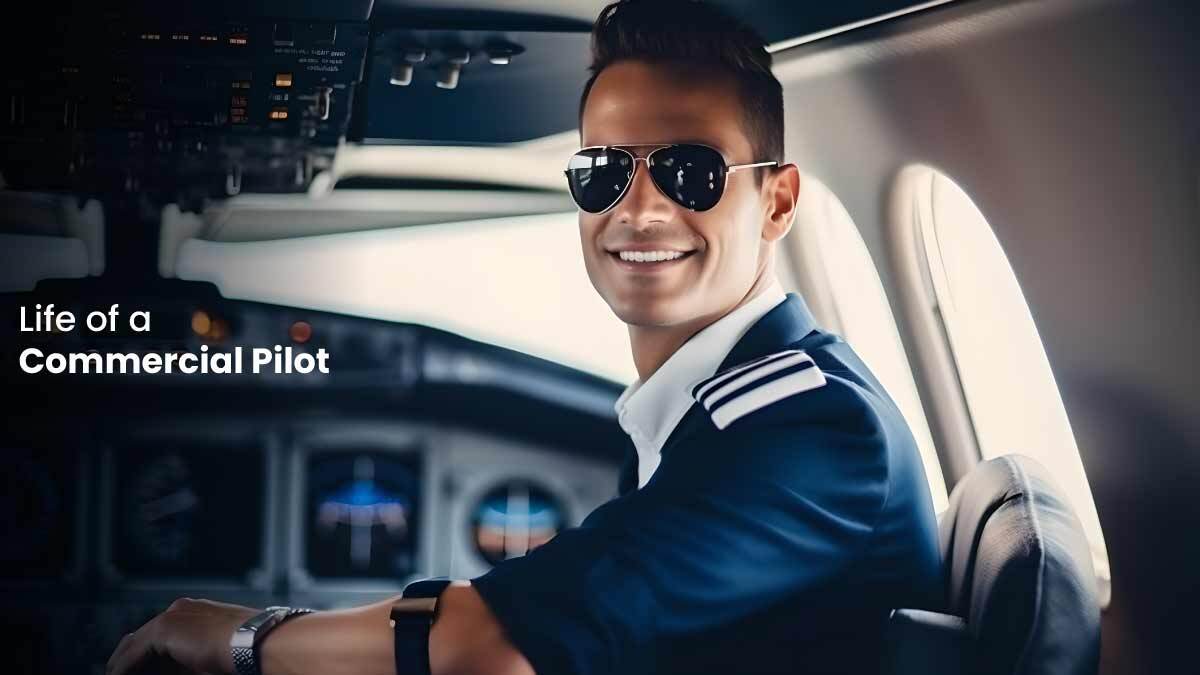
Ever wondered what it takes to be a commercial pilot? Want to know how a commercial pilot’s life unfolds? Join us as we explore the journey of a commercial pilot, unveiling the intricacies, challenges, and thrills of life at 35,000 feet. Let’s explore the dynamic experiences and professional insights shared by seasoned aviators soaring through the skies day in and day out.
From the breathtaking vistas witnessed through cockpit windows to the adrenaline-pumping moments of navigating through turbulent weather, our blog aims to paint a vivid portrait of the daily life, trials, and challenges encountered by those entrusted with the responsibility of ferrying passengers safely to their destinations.
What Does a Commercial Pilot’s Life Look Like?
Diversity in Schedule: One of the most appealing aspects of being a commercial pilot is the diversity it offers. Every day brings new destinations, new challenges, and new experiences. Whether flying short-haul routes or long-haul international flights, pilots have the opportunity to explore different cultures and landscapes, all while doing what they love.
Frequent Travels: Commercial pilots are constantly on the move, flying to various destinations both domestically and internationally. They have the privilege of visiting cities and countries around the world, often experiencing diverse cultures, cuisines, and landscapes. Each flight presents a new adventure, whether it’s soaring over snow-capped mountains, skimming over turquoise seas, or descending into bustling urban centres.
Exploring Countries: While the primary purpose of a pilot’s travel is for work, they often have layovers or overnight stays in different cities, allowing them to explore and experience the local culture. Whether it’s sampling street food in Bangkok, strolling through historic European towns, or hiking in the wilderness of New Zealand, pilots have the opportunity to immerse themselves in the destinations they visit, even if only for a short time.
Work-Life Balance: Despite the allure of travel and adventure, the life of a commercial pilot can also be demanding in terms of time away from home. Pilots often work irregular hours, including early mornings, late nights, weekends, and holidays. However, many pilots find ways to balance their professional and personal lives, making the most of their time off to reconnect with loved ones and pursue hobbies and interests outside of aviation.
Challenges: Alongside the excitement of flying comes a significant amount of responsibility. Pilots face challenges in navigating through unpredictable weather conditions and addressing technical issues with aircraft systems. They must adhere to stringent aviation regulations, manage fatigue effectively, and communicate clearly with air traffic control and crew members. Making critical decisions under pressure and handling emergencies with composure are integral parts of a pilot’s role.
Enjoying Life and Leisure: Despite the demands of their profession, commercial pilots do find time to enjoy life and leisure activities. During layovers or days off, they can indulge in hobbies such as golfing, skiing, scuba diving, or simply relaxing on a beach. Many airlines provide their pilots with access to recreational facilities, discounted travel benefits, and accommodations in luxury hotels, allowing them to unwind and recharge between flights.
Rewards and Fulfillment: Despite the challenges, the life of a commercial pilot offers numerous rewards and a profound sense of fulfilment. There’s a unique satisfaction that comes from mastering the art of flight, from the adrenaline rush of takeoff to the serenity of cruising at altitude. For many pilots, the opportunity to travel the world, meet new people, and experience different cultures is unmatched by any other profession.
Continuous Learning and Growth: Aviation is an ever-evolving industry, and commercial pilots are required to stay abreast of the latest advancements in technology, safety protocols, and regulatory requirements. Pilots undergo recurrent training and regular proficiency checks to maintain their skills and certifications. This commitment to continuous learning ensures that pilots remain competent throughout their careers.
Luxury Lifestyle: While not every aspect of a pilot’s life is glamorous, there are certainly elements of luxury associated with the profession. Pilots often enjoy perks such as first-class travel, exclusive airport lounges, and preferential treatment at hotels and restaurants. They sometimes have access to high-end amenities and services while on duty, such as private transportation and gourmet catering. Additionally, the financial rewards of a successful aviation career can afford pilots the opportunity to indulge in luxury goods, fine dining, and upscale experiences during their downtime.
Join IndiGo’s Cadet Pilot Program from Insight Aviation, the best commercial pilot course in India, and get your commercial pilot license to fly, making your dreams come true. Visit their website to know more about the modules, duration and other details like commercial pilot course fees in India. While the journey to becoming a commercial pilot may be challenging, the rewards are immeasurable. From competitive salaries and travel perks to the satisfaction of making a difference in people’s lives, the life of a commercial pilot offers a unique blend of excitement, adventure, and fulfilment. Join Insight Aviation as we navigate the skies and explore the fascinating world of commercial aviation!
FAQs
Q. Is piloting a lifetime job?
A. A pilot also has a retirement age, as per the currently existing rules, you can continue working as a pilot in an airline till the age of 65 years.
Q. Do pilots fly every day?
A. No, there is no specific rule for flying each day by a pilot, the flights are scheduled according to the aviation requirements and the pilot has to follow the schedule.
Q. What age do most commercial pilots retire?
A. Most airlines have rules of retirement for pilots at 65 years of age.

